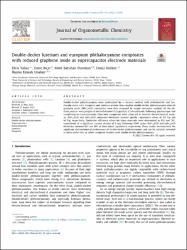| dc.contributor.author | Ebru YABAŞ | |
| dc.contributor.author | Emre Biçer | |
| dc.contributor.author | Mete Batuhan Durukan | |
| dc.contributor.author | Deniz Keskin | |
| dc.contributor.author | Husnu Emrah Unalan | |
| dc.date.accessioned | 2023-04-12T08:46:48Z | |
| dc.date.available | 2023-04-12T08:46:48Z | |
| dc.date.issued | 2022 | tr |
| dc.identifier.uri | https://hdl.handle.net/20.500.12418/13637 | |
| dc.description.abstract | Double-decker phthalocyanines were synthesized by a classical method with phthalonitrile and lan- thanide metal salts, europium and lutetium acetate. Non-covalent double-decker phthalocyanine-reduced graphene oxide (MPc 2 /rGO) composites were then prepared by simple sonication method. All the ph- thalocyanines were peripheral tetrasubstituted 5-(3-pyridyl)-1,3,4-oxadiazole. Following spectroscopic and morphological characterisation, fabricated composites were subjected to detailed electrochemical analy- sis. EuPc 2 /rGO and LuPc 2 /rGO composite electrodes showed specific capacitance values of 115 F/g and 86 F/g, respectively. Coulombic efficiency values for those materials were determined as 85% and 74%, respectively, at a significant current density of 5 A/g. Following 50 0 0 cycles, EuPc 2 /rGO and LuPc 2 /rGO electrodes retained 93% and 99% of their initial capacitance, respectively. These results demonstrated the significant electrochemical performance of double-decker phthalocyanines and can be certainly extended to other metal salts or other composite formers with double-decker phthalocyanines. | tr |
| dc.rights | info:eu-repo/semantics/openAccess | tr |
| dc.title | Double-decker lutetium and europium phthalocyanine composites with re duce d graphene oxide as supercapacitor electrode materials | tr |
| dc.type | article | tr |
| dc.contributor.department | İmranlı Meslek Yüksekokulu | tr |
| dc.contributor.authorID | 0000-0001-7163-3057 | tr |
| dc.relation.publicationcategory | Uluslararası Hakemli Dergide Makale - Kurum Öğretim Elemanı | tr |















